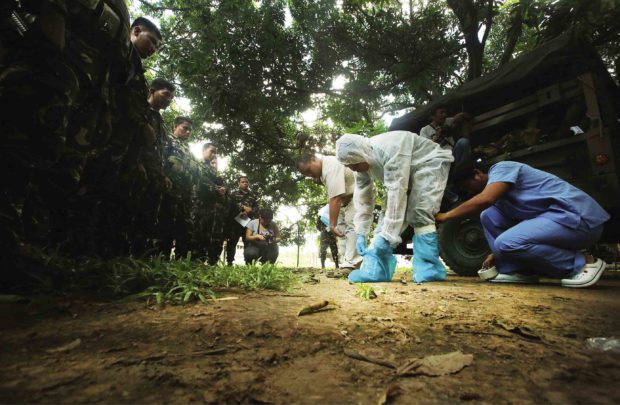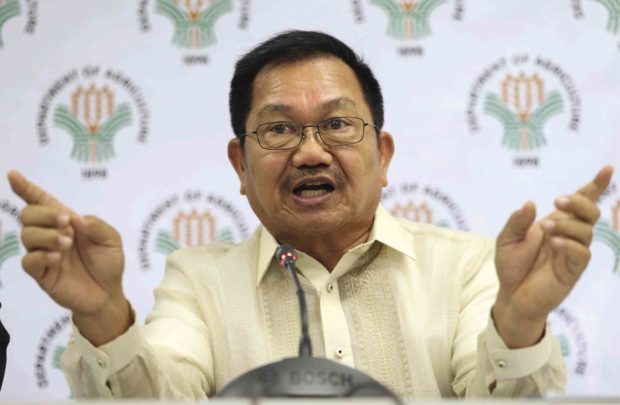Australia tests confirm bird flu

SUIT UP Soldiers watch veterinarians assist their colleague in wearing a protective suit before they are sent to a poultry farm in San Luis town, Pampanga, to contain the spread of bird flu. —GRIG C. MONTEGRANDE
CITY OF SAN FERNANDO — The picture of the avian influenza outbreak that struck three towns in Central Luzon remains incomplete despite tests done in Australia confirming that the region was indeed hit by the bird flu.
This was why the Bureau of Animal Industry (BAI) sought more tests by the Australian Animal Health Laboratory (AAHL) to determine the strain found in poultry farms in San Luis town in Pampanga province and San Isidro and Jaen towns in Nueva Ecija province.
“What avian flu strain hit us in the Philippines? We should have complete information so we can improve our defenses,” Dr. Arlene Vytiaco, coordinator of the BAI’s avian influenza control program, told the Inquirer by telephone on Wednesday.
Different strains
In AAHL tests done on Aug. 21, 11 samples of tissues and oral swabs tested positive for avian influenza but were negative for the H5N1 strain, which has been known to spread to humans.
Based on reports from 16 countries since 2003, the World Health Organization (WHO) documented 453 deaths in 859 cases of H5N1, mostly from Indonesia and Egypt.
According to WHO, H5N1 was first recorded in 1995 in Hong Kong. Human infections from another strain, H7N9, was reported in China in 2013. Another strain, H5N6, was detected in Taiwan in February this year.
“Whether it is N1 or N6, the government would have the same responses in controlling the outbreak,” Vytiaco said.
According to Agriculture Secretary Manny Piñol, the government has already contained the spread of the virus that hit Pampanga and Nueva Ecija.
The Department of Agriculture (DA) said the number of chickens, ducks and quails destroyed within the 1-kilometer quarantine zone in San Luis reached 158,567 while 289,136 birds were culled within a 7-km control zone surrounding the quarantined farms.
In Nueva Ecija, the government has culled 100,167 quails in Barangay Imbunia in Jaen and 57,300 egg-laying chickens in Barangay San Roque in San Isidro.
Culling was scheduled to be completed on Wednesday night, according to DA Central Luzon Director Roy Abaya.
But Nueva Ecija officials said they wanted to know if the virus that affected Pampanga was the same strain that infected poultry in San Isidro and Jaen, about 50 km from San Luis.
On Tuesday, the Nueva Ecija provincial board placed San Isidro and Jaen under a state of calamity. The board also approved another measure releasing P2.7 million of the province’s unused 2016 calamity fund to support the culling of infected birds.

Agriculture Secretary Manny Piñol
Cockfights banned
The board also banned cockfights in the province for two weeks, on the endorsement of the local game fowl organization.
Piñol’s Facebook post addressed what he believed were accusations that the DA “acted hastily in declaring the outbreak and instituting strict quarantine measures which affected the livelihood of farmers.”
He referred to a statement made by former Candaba Mayor Jerry Pelayo. “Personally, I was offended by the accusations because these had the implications that I am an irresponsible leader who makes decisions without the benefit of the wisdom of experts … likening that to being called a charlatan.”
Quarantine measures
“Had I listened to kibitzers, God knows how far the bird flu virus could have spread,” he said. “With the advice of biosecurity experts, we were able to implement immediate and tough quarantine measures and in just two weeks succeeded in containing the spread of the virus.”
“Now, we will focus on how to bring the poultry industry back on its feet,” he added.
Pelayo said: “I did not blame Piñol for the effects of his declaration of the outbreak. I merely stated a matter of fact that it was not yet the migratory bird season.”














